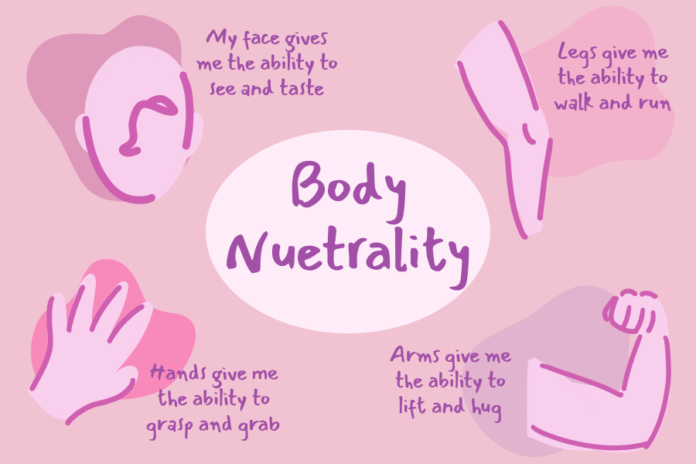And why we may be moving into a body-neutral future
By CORALIE LOON — arts@theaggie.org
If you’ve been on social media recently, you may have noticed a term gaining popularity and traction: body neutrality. Whether you’ve seen the term mentioned by a celebrity, on an educational Instagram post or used as a hashtag, it has been circulating the internet and challenging the approach of the body positivity (BoPo) movement.
The body positivity (BoPo) movement, which emerged in the 1960s during the fat acceptance movement, aims to “[promote] love and acceptance of the body in an effort to improve body image.” The movement as we know it today first appeared on Instagram in 2012 and is mentioned in millions of posts.
After decades of exhaustion from super-skinny influencers like Kate Moss, the glamorization of drug use and eating disorders — culminating in the “heroin chic” aesthetic — and the constant perfectionism expected of women’s bodies perpetuated by photoshop, it’s no surprise that a countermovement in beauty standards emerged. BoPo discards the idea that any particular type of body is the” ideal,” and instead maintains that “all people deserve to have a positive body image, regardless of how society and popular culture view ideal shape, size, and appearance,” according to Verywell Mind.
With the rise of the movement came the rise of body-positive influencers, like Tess Holliday and Jessamyn Stanley. On their feeds, cellulite and stretch marks were not things to be ashamed of but things to be celebrated. Companies like Aerie also began to participate in the movement, launching campaigns spreading body positive messages. Even Target committed to abandoning photoshop beginning with their 2017 swimsuit campaign.
But while the BoPo movement is an important (and even revolutionary) way to challenge what many young women think they know about beauty, in practice, it hasn’t always been able to achieve its goals. According to Medical News Today, studies have shown that most posts using BoPo hashtags “feature young, white, non-disabled females.” Additionally, with its emphasis on positive affirmations and the rejection of all negative self-talk, body positivity runs the risk of becoming a form of toxic positivity, which can lead to suppressing one’s emotions and “experiencing guilt” from feeling emotions that aren’t happiness or love.
Also, for people who’ve been fed negative messages about their bodies for years, the expectation to suddenly love their appearance may just feel like another expectation to either live up to or fail at. Focusing on appearances, positive or negative, can lead to its own form of exhaustion. For this reason, body neutrality may seem like a more appealing alternative to some.
Rather than focusing on what the body looks like, the body neutrality movement focuses on how the body feels and what it can do. According to the New York Times, body image coach Anne Poirier popularized the term in 2015 as a way to help people with negative relationships to their bodies. The goal is neither to love nor hate your body, but to feel no particular way about it.
Since body neutrality focuses on how the body feels and functions, it can also be helpful in forming a healthy workout routine by shifting the focus of movement from future goals to present enjoyment.
Instead of positive affirmations, body neutrality urges people to focus on phrases that don’t refer to appearance, like: “my thighs are strong and help me walk,” “my arms allow me to hug the ones I love” or “my weight does not define my worth.”
This is because body neutrality aims to avoid both the fixation on the body’s appearance and the possibly unrealistic expectation to go from body hatred to body love.
Even those who are viewed as advocates for the body positive movement, such as actress and public figure Jameela Jamil, sometimes don’t support all aspects of BoPo. Instead, she explained that she believes in body liberation and body neutrality in an interview with Trevor Noah. In a post on the Instagram account for her podcast, “I Weigh,” Jamil urged her followers to shift conversations away from the body, its weight or its shape, and to instead practice using neutral observations about themselves (rather than positive or negative).
Of course, this doesn’t mean that one can’t have an opinion about their body, or that body-confident individuals should stop loving their bodies. It just means that it isn’t necessary to always love how your body looks in order to feel satisfied, worthy of love or happy with your life.
In the future, it’s unclear how conversations regarding bodies will continue evolving. We constantly see cycles of trends followed by trend-exhaustion, such as the extra skinny “supermodel” trend of the early 2000s followed directly by the “slim thick” trend of the mid-2010s. To some, body positivity may feel like a counter-trend to the merciless perpetuation of white, tanned skinny bodies, while body neutrality may be the middle ground that outlives them both.
But whether you feel more connected to one movement or the other, the goal of both is to imagine a future where beauty is individual, acceptance is limitless and all souls can heal their broken relationships to their bodies.
Written by: Coralie Loon — arts@theaggie.org




